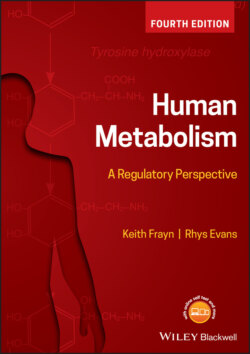Читать книгу Human Metabolism - Keith N. Frayn - Страница 38
1.3.2.1.5 Gluconeogenesis
ОглавлениеGluconeogenesis, despite its name (synthesis of new glucose), is a pathway typically active in catabolic states, when there is a need to make glucose from other fuels for organs that depend upon it. The pathway of glucose synthesis, gluconeogenesis, occurs primarily in liver cells (and to a lesser extent, in kidney) and is essentially a reversal of glycolysis (many of whose steps are freely reversible and shared by both pathways) although with some specific steps, circumventing the energy-yielding and largely irreversible steps of glycolysis (Figure 1.14). Reversal of the last step of glycolysis (phosphoenolpyruvate → pyruvate) requires formation of oxaloacetate, and spans the mitochondrion. The main regulatory enzyme of glycolysis, phosphofructokinase, must also be reversed, and for this gluconeogenesis uses fructose-1, 6-bisphosphatase. Finally, if free glucose is to be produced for export (liver), glucose 6-phosphate must be dephosphorylated to glucose by glucose-6-phosphatase – i.e. this is the final enzyme of both gluconeogenesis and glycogenolysis, both pathways allowing liver to export glucose and maintain blood glucose levels. The major substrate for gluconeogenesis is pyruvate; the major source of this under most conditions is lactate. Amino acids whose carbon skeletons can be converted to pyruvate (e.g. alanine, during starvation, discussed later) can also contribute, and in addition glycerol released from lipolysis of triacylglycerols in adipose tissue can enter the gluconeogenic pathway (and hence breakdown of storage lipids does yield a small amount of carbohydrate). Note that glucose is broken down to lactate (glycolysis) in red blood cells, for instance, and in anaerobic cells such as renal medulla: the lactate is transferred via the bloodstream to the liver where it is used to re-synthesise new glucose. This cycle is sometimes called the Cori Cycle (discussed further in Chapter 7). It does not result in irreversible loss of glucose from the body. Irreversible loss of glucose occurs after the action of PDH, as acetyl-CoA can no longer be reconverted to glucose (PDH is irreversible), and therefore acetyl-CoA is not a substrate for glucose synthesis.
